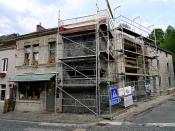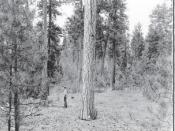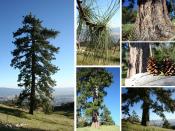Management practices such as the suppression and exclusion of fire in the Southwestern ponderosa pine ecosystem have created problems by notably disturbing natural fire patterns and native plant health. These practices increase incidences of dwarf mistletoe infections and the risk of catastrophic wildfires from hazardous fuel accumulations. This is a serious problem for managers and residents of this ecosystem.
Restoration and hazardous fuel reduction of the Southwestern ponderosa pine ecosystem should be the only methods used to reduce the threat of wildfires within the wildland-urban interface, as well as revitalize and sustain the health of this ecosystem.
Before European-American settlement, the ponderosa pine ecosystem consisted of large diameter, widely spaced trees visited frequently by low-intensity, surface fires.
The ponderosa pines have developed evolutionary traits such as: thick bark, prolific seed production, rapid seedling growth, long resinous needles that drop to the ground and produce highly flammable litter, and longevity, all of which are interpreted as adaptations to frequent, low-intensity, surface fires (Edmonds, 2000).
The ponderosa pines are a fire-dependant species and require frequent low-intensity, surface fires every two to ten years for their continuous survival. Surface fires, usually ignited by lightning, can remove much of the small, diseased, and dying vegetation (fuel). Without frequent surface fires, these fuels build upon the forest floor to create a ladder for an ignited fire to travel to the crown of the trees. Crown fires can produce catastrophic, heat-intensive fires that can burn away the forest floor, exposing the vulnerable mineral soil to erosion. When the mineral soil layer is damaged by a heat-intensive fire, much of the genetic materials and seeds can be lost from the resulting erosion and this can permanently alter the landscape. At this point after a heat-intensive fire, only bare soil remains and vegetation regeneration may be inhibited even...


